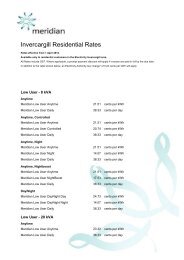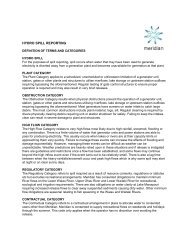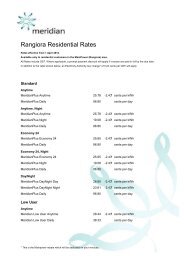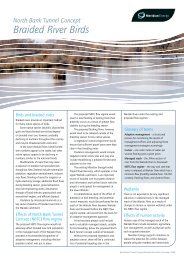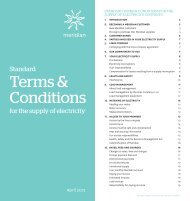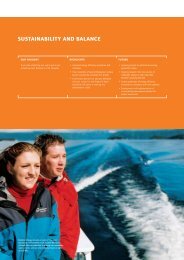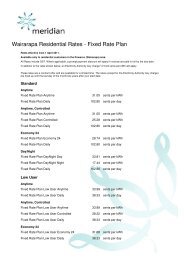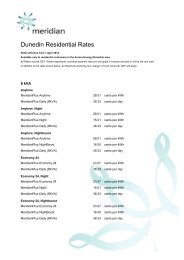Meridian Annual Report - Meridian Energy
Meridian Annual Report - Meridian Energy
Meridian Annual Report - Meridian Energy
You also want an ePaper? Increase the reach of your titles
YUMPU automatically turns print PDFs into web optimized ePapers that Google loves.
34<br />
Economic Overview and 2007/08 Financial Performance Commentary<br />
<strong>Meridian</strong>’s economic objective is to produce long-term shareholder<br />
value. We accomplish this goal by maximising the value from our<br />
portfolio of generation assets through well developed asset and risk<br />
management plans and optimisation strategies and investment in<br />
generation growth by pursuing our renewables strategy. We actively<br />
develop and participate in competitive wholesale and retail energy<br />
markets and have a major initiative under way to enhance customer<br />
value by transforming our customers’ experience and we are making<br />
investments that will provide future competitive advantage and<br />
commercial value.<br />
<strong>Meridian</strong>’s core business is the generation and retailing of electricity and<br />
wider complementary products and services. <strong>Meridian</strong> owns and operates<br />
nine South Island hydro stations and two wind farms, Te Āpiti and White<br />
Hill located in the North Island and South Island respectively. These<br />
assets provide <strong>Meridian</strong> with annual average generation capacity of<br />
12,500 GWh. This year we generated 11,908 GWh which is below average<br />
and largely attributable to low hydrology in the latter part of the year.<br />
Earnings Analysis<br />
<strong>Meridian</strong> typically generates more electricity than it is contracted to<br />
sell. However, the 2007/08 year was a challenging year for <strong>Meridian</strong><br />
with lower-than-average national hydro storage and inflows, coupled<br />
with equally as significant systems constraints resulting in exceptionally<br />
high spot generation prices, particularly in the last quarter of the year.<br />
The system constraints related to:<br />
• the unexpected closure of Pole 1 of the HVDC in September 2007;<br />
• the unexpected decommissioning of the New Plymouth thermal plant;<br />
• other prolonged thermal outages from February to April 2008;<br />
• the market impacts of the operation of the Government energy plant<br />
at Whirinaki coupled with unprecedented increases in diesel prices for<br />
this plant.<br />
The hydrology situation in our catchments in the last quarter resulted<br />
in significantly lower generation output than anticipated and exposure<br />
to net electricity purchases from the market at high prices to meet our<br />
contracted retail sales commitments.<br />
Operating revenue is predominantly derived from the sale of electricity<br />
to the wholesale electricity market and to retail electricity customers.<br />
Revenue from energy sales increased significantly for the year largely<br />
due to higher annual average generation spot prices of $111/MWh<br />
(2007: $53/MWh). The increase in price also impacted the cost of<br />
electricity purchased to meet our fixed price commitments to customers.<br />
The significant decline in Earnings before Interest, Tax, Depreciation,<br />
Ammortisation and Financial Instruments (“EBITDAF”) ($105.3 million)<br />
for the year was predominantly due to:<br />
• supplying contracted volumes of electricity at the higher spot prices<br />
in the latter part of the year ($356/MWh average in June this year<br />
compared to 2007 June average $69/MWh);<br />
• higher costs of delivery of energy-related services incurred by<br />
South Island generators during the dry hydrology period in the<br />
North Island; and<br />
• employee costs increasing in areas that reflect our commitment to<br />
enhancing customer value and in start-up subsidiaries (Right House<br />
and PowerShop) that will provide future competitive advantage and<br />
commercial value.<br />
Depreciation expense for 2008 has increased as a result of the fair<br />
value adjustments to the carrying value of the generation assets in<br />
2007 ($1,455 million).<br />
Unrealised net (losses)/gains on financial instruments recognised in<br />
the income statement relate to unrealised fair value movements on<br />
derivative instruments used for risk management purposes for which<br />
<strong>Meridian</strong> has not adopted hedge accounting. The net movement this<br />
year is positive ($31.2 million) but is subject to volatility due to<br />
fluctuations in electricity/aluminium prices and interest rates.<br />
Underlying profit after tax is presented in order to assist the users’<br />
understanding of the financial information presented, and in particular<br />
the Group’s underlying business performance, by removing the volatility<br />
of unrealised net (losses)/gains on financial instruments and other<br />
one-off items.<br />
The increase in net finance costs reflects the cost of additional<br />
borrowings and facilities that <strong>Meridian</strong> has sourced during the year,<br />
together with increased interest rates.<br />
The effective rate of tax for the year is 35% compared to 28.8% last year.<br />
The positive effect of the corporate tax rate reduction on deferred tax of<br />
$2.9 million (2007: $16.7 million) was offset by tax on an intercompany<br />
dividend that was not deductible. A reduction in the corporate tax rate<br />
from 33% to 30% was announced in the 2007 Budget and received<br />
Royal Ascent. For <strong>Meridian</strong>, this reduction is effective from 1 July 2008.<br />
Balance Sheet<br />
Despite a very challenging year, <strong>Meridian</strong>’s balance sheet remains<br />
in a strong position with shareholders’ funds of $4,204.6 million and<br />
a gearing ratio of 18.3%. Given the strength of <strong>Meridian</strong>’s financial<br />
position, the Board approved dividend payments of $297.9 million for<br />
the year, bringing the total dividends paid by <strong>Meridian</strong> since inception<br />
in 1999 to $2,100 million.<br />
Electricity generation is an asset intensive business as is reflected<br />
in the level of investment in property, plant and equipment. <strong>Meridian</strong><br />
carries these assets at fair value as determined by an external valuer.<br />
Since inception, fair value adjustments of $3,953 million have been<br />
recognised, impacting return on average equity.<br />
Current assets and current liabilities reflect amounts due and payable<br />
for electricity sales and purchases. These amounts are significantly<br />
higher than in previous years, primarily due to high year-end spot<br />
prices of $356/MWh (2007: $69/MWh).<br />
Derivative financial instruments are recorded on the balance sheet<br />
at their fair values in accordance with New Zealand International<br />
Financial <strong>Report</strong>ing Standards (NZ IFRS).<br />
<strong>Meridian</strong> increased its borrowings during the year to fund its capital<br />
expenditure programme which included the commencement of<br />
construction of the West Wind wind farm in Wellington and a portion<br />
of the February 2007 shareholder dividend payment.<br />
Deferred tax balances include deferred tax on the fair value<br />
adjustments made in respect of the generation assets.



